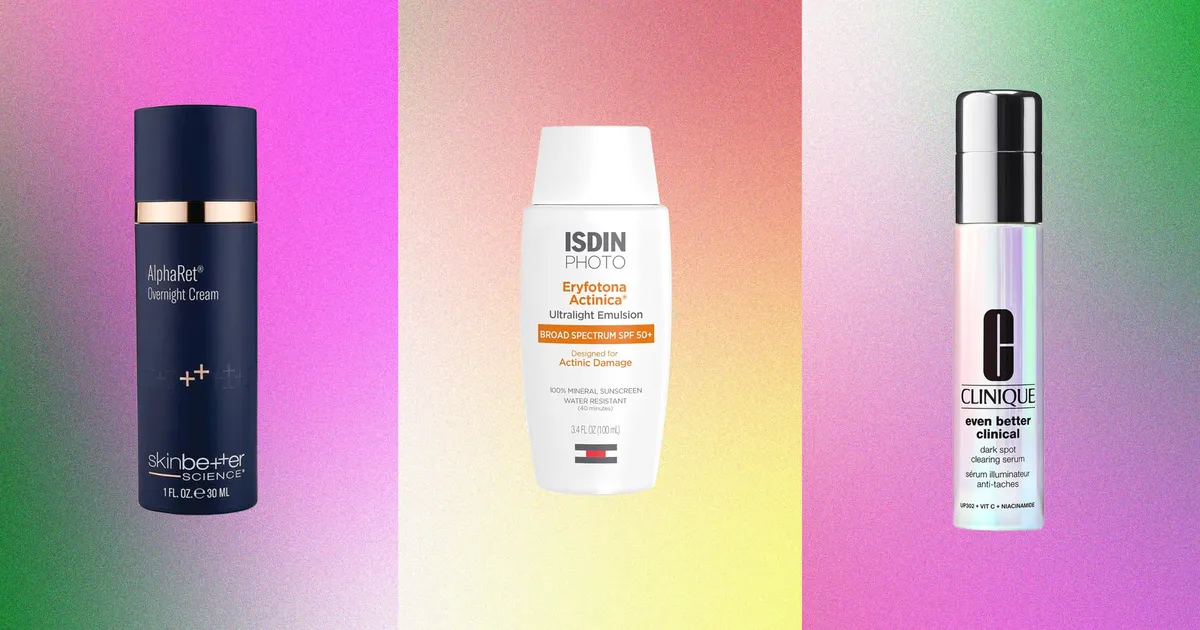Copyright New York Magazine

Welcome to Wrinkles Week on the Strategist, where we’re deeply vetting skin-care solutions for anyone looking to smooth fine lines and wrinkles (or prevent them from showing up in the first place). For more, head to our Wrinkles Week hub. Caring for the neck is different from the face — the skin there is thinner and more sensitive. There are fewer oil glands — about an eighth of the ones on your face — so it dries out faster, which can show up in fine lines and wrinkles before these make their appearance above the jawline. How this looks for you mostly comes down to genetics. There are two ways skin ages: intrinsically and extrinsically. Intrinsic aging is genetic and unique. There’s not much you can do about it, though if you look at your family members there may be some clues about how this process will go. Extrinsic aging refers to the environmental factors that impact the way you age — from lifestyle habits like smoking or staring down at your phone or UV damage. These things are controllable but unchecked can have really noticeable effects. UV exposure, for example, fragments and breaks apart collagen and elastin over time. Smoking reduces blood flow to the skin, which decreases collagen and elastin production. A typical first sign of neck aging is discoloration. “That means the sun has taken its toll, and you haven’t been good about sunscreen. So that’s probably your first indication of like, all right, let me get it together,” says Dr. Corey L. Hartman, a dermatologist. That can look like bringing your moisturizers and actives down onto your neck and diligently wearing sunscreen. The next step is wrinkling and “necklace lines.” You may notice that when you tilt your head down, the lines that form remain, even when you’re relaxed. At this point, you can still benefit from topical creams like retinols and peptides. With the neck, you want to address any areas of concern early, if not proactively. “The best treatment is prevention,” says Dr. Melanie Palm, a dermatologist, especially if you want to use topical creams, which become less effective once you start trying to tackle deep-set wrinkles and jowls. Clinical dermatological surgeon at Lenox Hospital and founder of Sobel Skin Rx Howard Sobel, M.D., agrees: “The later you start, the longer it’ll take you to repair the damage.” Certain neck concerns, like sagging skin and deep-set wrinkles or visible banding, can be slightly improved by a cream, but it won’t be revolutionary. With that said, if you start early, you can preserve more of the collagen you do have, which can push the need for more expensive in-office treatments further down the line. “There are people who come in all the time, and I’m like, Your neck is in really good shape,” says Dr. Hartman. “And it didn’t take anything heroic. It just took paying attention and consistency. Perhaps surprisingly, neck-specific creams were the least recommended by the dermatologists I spoke to. This is because neck creams don’t really offer anything a regular moisturizer or retinol or serum does not. With that said, there are some neck creams that dermatologists said are worthwhile, especially if you’re dealing with specific skin concerns like poikiloderma of civatte, a condition triggered by chronic sun exposure that’s characterized by reddish-brown patches that can be difficult to treat. Retinols are by and large the main recommendation for addressing neck skin. “It should be in everybody’s arsenal,” says Dr. Palm. “It thickens your skin; there’s six decades of research to show its capabilities.” Dr. Sobel agrees. “Its one of the only products that’s been shown to increase collagen and elastin production,” he says. He recommends starting to incorporate retinol in your late 20s and early 30s, when wrinkles begin to develop, and being consistent, as it takes anywhere from two to four months to see a difference. As I said above, the neck is more sensitive so dermatologists recommend approaching retinols on the neck cautiously. You don’t need to use an entirely different product, but you may want to use it less frequently. For example, if you’re using a retinol four times a week on your face, you might use it twice on your neck. Palm recommends picking a retinol with a slower release mechanism (this makes it less irritating as it sinks into the skin) and bringing it from the face down to the neck. If you’re using a product with a high concentration of retinol, she says it can be mixed with a moisturizer to dilute it. Saved View Want to be emailed when products you’ve saved are over 20% off? Success! You'll get an email when something you've saved goes on sale. Yes New! You can now save this product for later. Dr. Palm likes this retinol from SkinBetter, which happens to be my top retinol pick. In addition to vitamin A it also contains alpha-hydroxy acids, exfoliating ingredients that help to get rid of dead skin cells. There’s also a mix of ceramides, squalane, niacinamide, and hyaluronic acid, which helps to moisturize skin. After using this for many months with little irritation I can vouch that it’s a solid option if you have more sensitive skin, though like any retinol, I’d go slowly. Saved View Want to be emailed when products you’ve saved are over 20% off? Success! You'll get an email when something you've saved goes on sale. Yes New! You can now save this product for later. For a cost-effective option, Dr. Palm recommends Differin. The main ingredient in the acne-fighting gel is adapalene, a topical retinoid that’s typically recommended for acne. It’s known for being better tolerated than tretinoin — a prescription retinoid — and it’s more affordable too. Peptides can and should be used in conjunction with your retinol. Peptides are fragments of proteins, which trigger a response in the cells to stimulate collagen production. Beginning around 30, a process called glycation starts to happen, a process where glucose attaches to proteins. This causes cellular dysfunction and can trigger inflammation along with skin aging — peptides can help to neutralize the effects. “There are peptides out there that have been shown to build collagen elastin and clean out advanced glycation,” says Palm. Saved View Want to be emailed when products you’ve saved are over 20% off? Success! You'll get an email when something you've saved goes on sale. Yes New! You can now save this product for later. There are a few ways to incorporate peptides into your skin-care routine, but I recommend a moisturizer because it’s an easy swap and won’t be an extra step to remember. A good rule of thumb when choosing one is to pick one with a well-known peptide complex like Matrixyl-3000 or a product with lots of clinical studies so you know it actually works. This one from Allies of Skin is a favorite of Dr. Julian Sass, a cosmetic chemist, because it has solid clinical evidence and contains seven peptides along with an algae complex that encourages cell turnover. I can’t overstate how important sunscreen is for protecting the skin on your neck. Even without active ingredients like retinol, which makes skin sun-sensitive, UV radiation generates free radicals, unstable molecules that can cause damage to cells. “When you look under a microscope, you can see all this disfigured collagen and elastin,” says Dr. Mark. “I do skin-cancer surgeries, and when I’m looking to assess the skin-cancer margins, I see the quality of the skin and you can really see the difference between an 80-year-old from Florida and a 40-year-old from New York.” The visual effect of UV damage ranges from hyperpigmentation to wrinkling. Sunscreen helps to protect from this. “Apply it liberally,” says Dr. Sobel. “Put on at least two tablespoons every two to three hours,” he says. Saved View Want to be emailed when products you’ve saved are over 20% off? Success! You'll get an email when something you've saved goes on sale. Yes New! You can now save this product for later. Our oft-recommended EltaMD sunscreen is a good option for most people. It’s a hybrid formula, meaning it has both chemical and physical sunscreen filters, which means you get the benefits of both formats. Another reason why we recommend it is because it contains antioxidants, which help to protect your skin from free radicals that damage healthy skin through oxidative stress and impact collagen and elastin production. Considering that advanced glycation end products, or AGEs, are also impacting your skin, it helps to mitigate at least one process damaging your skin. I also like that it comes in different tints, so it works well for a wide range of skin tones. Saved View Want to be emailed when products you’ve saved are over 20% off? Success! You'll get an email when something you've saved goes on sale. Yes New! You can now save this product for later. We also recommend this antioxidant-rich sunscreen. It contains photolyase enzymes, which use visible light to reverse UV damage. It’s a favorite of Dr. Hartman, who uses it on himself. He likes it for the ingredients but also because it doesn’t leave a white or purplish cast. There’s also a tinted formulation, which dries down totally invisible. On that same note, Dr. Sobel recommends adding antioxidants like vitamin C into your routine, which helps to protect from free radicals. “It helps to protect from damaging the healthy cells,” he says. Saved View Want to be emailed when products you’ve saved are over 20% off? Success! You'll get an email when something you've saved goes on sale. Yes New! You can now save this product for later. $93 If your sunscreen doesn’t already contain an antioxidant, a vitamin-C serum could be a worthwhile addition to your routine. Both former Strategist writer Rachael Griffiths and I swear by this dark-spot serum from Clinique, which contains two types of vitamin C and niacinamide as well as UP302, a synthetic formulation of dianella ensifolia, a plant that helps to address hyperpigmentation. It works particularly well on my deep skin tone — I noticed even the most stubborn darkness on my chin has lightened up with continued use. I also bring it down to my neck, where I have some hyperpigmentation from tweezing ingrown hairs, and it has helped with that too. As for light-therapy treatments like red light (red light has been shown to stimulate collagen production), they may offer better results but at a cost. It’s also about consistency. “You really have to do it five days a week, and few people will actually commit to that,” says Dr. Palm. “I think skin care and a little toxin and some of these collagen stimulators is probably going to yield you better results.” Saved View Want to be emailed when products you’ve saved are over 20% off? Success! You'll get an email when something you've saved goes on sale. Yes New! You can now save this product for later. $395 Our favorite red-light tool is this face mask from Omnilux, which uses red and near-infrared LEDs. It has a velcro strap so it can be worn hands-free and bendable sides so the lights can sit closely to the skin. There are more than 40 peer-reviewed studies that back up its efficacy, which makes the sub-$400 price tag feel worth it. No dermatologist recommended splurging on a microcurrent device like a NuFace, which works by sending electrical currents under the skin and stimulating the muscle. “They work very temporarily — a couple hours or the night — there’s no real long-term effect,” says Dr. Sobel. Nanocurrent devices, like Ziip, operate at an even lower electrical frequency and are meant to offer longer-lasting, more permanent results. With that said, it requires daily use for the first three months, then continuous maintenance, and even then, it might not make a big difference. According to Dr. Hartman, once you start to see deep-set wrinkles and horizontal lines, it’s unlikely that topical treatments at home will make a huge difference. As early as your 20s, skin naturally begins to thin. It’s not immediately obvious, but over time this will highlight what lies underneath. In the case of the neck, this can look like a prominent platysma muscle, or “neck bands,” which drapes around the jawline, goes down the neck, and ends at the collarbone. Because this is a result of thinning skin highlighting what’s underneath, it isn’t something that can be addressed exclusively with skin care, especially once it’s very prominent. Using a retinol or peptides may help with encouraging collagen production, and a hydrating ingredient like hyaluronic acid may make the skin appear more hydrated, but it won’t reverse what you’re seeing. If you’re looking to make a major change in neck bands, you’ll have to opt for an in-office treatment like Botox, which was recently cleared by the FDA for band injection or a neck lift, which rejoins the muscle. Botox temporarily blocks the nerve signal to muscles, which is why it’s popular for sort of “freezing” muscles in their place, including the platysmal bands. The neurotoxin was recently approved by the FDA for platysmal-band injections, but many doctors have been doing it for longer. Dr. Mark, who has been practicing since 1999, has been doing it since 2001. “It was called the Nefertiti neck-lift, where we weaken the platysmal bands and the muscles along the jawline that pull down. It helps with jowls,” he says. By injecting Botox into the neck, it reduces the amount of unnecessary muscle movement, which reduces visible aging on the neck. The advantage of Botox, says Dr. Mark, is that it doesn’t add volume like filler. The downside is that it’s fast acting and can wear off in a few months. There’s a growing interest in using fillers to address neck laxity. With fillers, he says, timing is key. By using fillers and Botox at the early signs of neck aging, it can push interventions like surgery down the line, if not erase the need for it. Which filler you choose depends on your desired result. Hyaluronic-acid fillers, like Voluma, add volume, and can be injected into the jawline. “It has dramatic lifting capacity,” says Dr. Mark. This helps to reduce the look of sagging skin, which can make the neck appear more lifted. With that said, hyaluronic-acid fillers like Juvéderm and Volux shouldn’t be injected directly into the neck because the skin is very thin. But collagen-stimulating injectables, like Sculptra and Radiesse, can be. These encourage your body to trigger its natural collagen-building process with results developing over time. Dr. Palm has personally done her “tech neck” lines — horizontal wrinkles across the neck — and says it got rid of them. To do this, Dr. Palm uses a “hyperdilute” formula, meaning a higher level of diluent-to-filler ratio so it can be used effectively in areas outside the face, and injects with a cannula, a blunt needle. “We’re right under the surface of the skin,” she says. These injections are done over a series of appointments and require some maintenance after a year or 18 months. In those maintenance appointments, Dr. Palm will refresh the filler but not repeat the initial series of injections. It’s important to note that injecting these areas is considered an off-label use, so Dr. Palm doesn’t recommend going just anywhere to have it done. “You need a very skilled injector, somebody with good experience,” she says. “I would definitely ask about their level of expertise and how many cases they’ve done.” Another option for the neck is skin-tightening treatments like ultrasound and radio-frequency microneedling. All of these technologies work by heating collagen to stimulate new collagen growth. “It’s all about heat and where you’re putting the heat,” says Dr. Palm. Radio-frequency microneedling works by creating small wounds in the skin with a very tiny needle and then delivering radio frequency to the skin. This triggers the body’s healing response and encourages skin to make fresh collagen, which helps to fill in lines and tighten sagging skin. This usually requires a few treatments to see results. Dr. Mark also recommends boosting the treatment with platelet-derived growth factors, or PDGF, a protein that’s applied topically and stimulates skin repair and encourages collagen production. “It’s the next frontier,” he says. Ultrasound therapy uses sound to create heat. It goes deep into the dermis — up to five millimeters — and this helps to stimulate collagen production and elastin generation. It’s often framed as a subtler and noninvasive alternative to a face-lift, but it’s important to be realistic about results. It works best if you’re in the earlier stages of neck aging, so it wouldn’t necessarily be the best option for jowls, and the results aren’t instantaneous. Instead, you’ll see improvements over a few months. Both treatments can be effective, but Dr. Palm cautions against going too deep into the skin. “You really want to be targeting the dermis,” she says, “maybe one to two millimeters.” At that depth, you can achieve a fair amount of collagen stimulation without damaging the skin. Deeper, and you risk triggering inflammation and possibly creating scar tissue. “I would not be a fan of doing deeper settings if you’re considering doing surgery in the next five to ten years,” says Palm. More From The Strategist The Best Clean Anti-Aging Skin-care Routine, According to Experts An Advent Calendar for Every Kind of Person The Best in Class Hall of Fame I Own 20 Pairs of Loafers. These Are the Ones Worth Buying. See All



